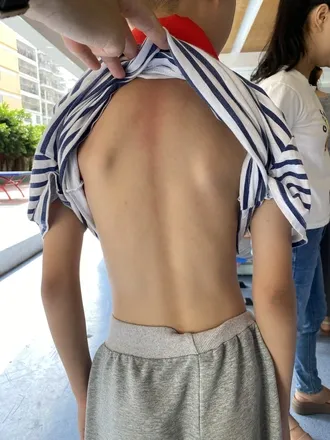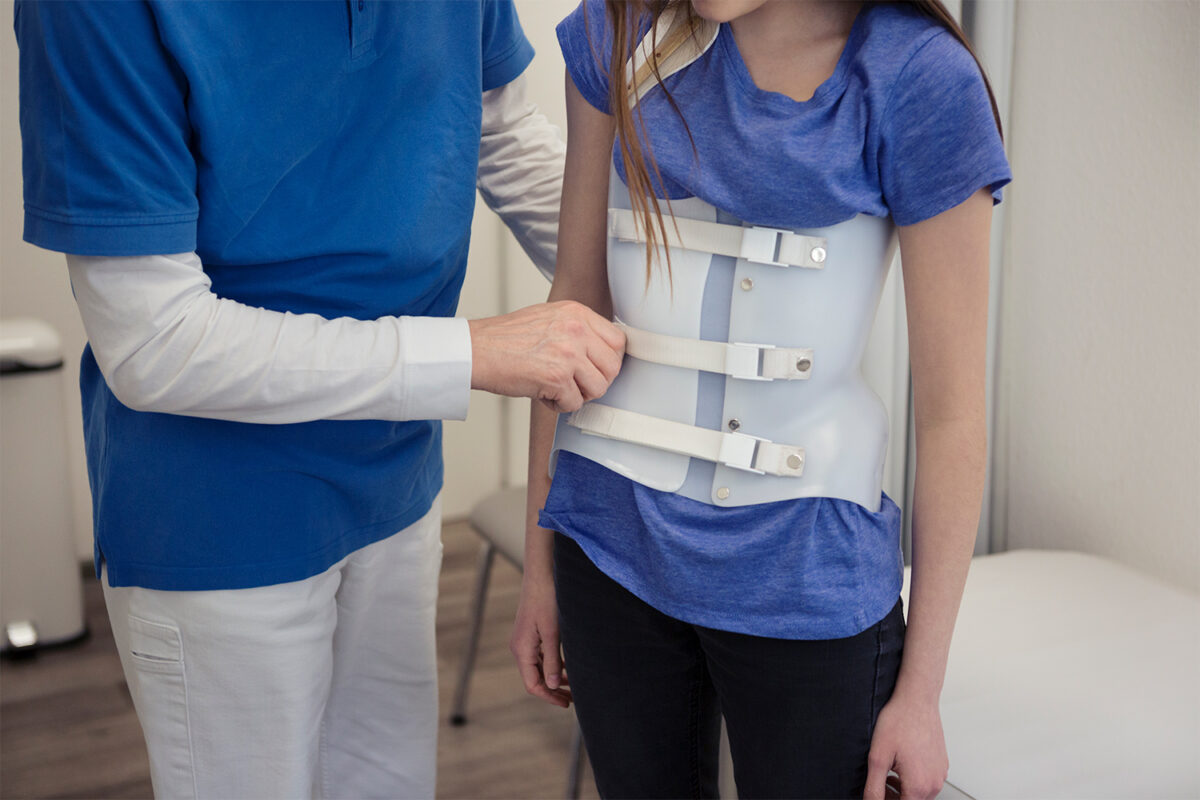肩甲骨翼状側弯症:問題への対処と治療法
Introduction
Scoliosis is a spinal condition characterized by an abnormal curvature, leading to potential complications such as a winged scapula. In this condition, the shoulder blade protrudes from the back, causing pain and limited mobility. Understanding the interplay between scoliosis and winged scapula is crucial for effective diagnosis and treatment. This article explores the causes, symptoms, diagnosis, and treatment options for individuals with both scoliosis and winged scapula.
Understanding Winged Scapula
The scapula, commonly known as the shoulder blade, typically lies flat against the ribcage. In cases of winged scapula, the scapula protrudes outward, resembling a wing. This abnormality often results from muscle weakness, nerve damage, or skeletal imbalances . The condition can significantly impact shoulder function and may be exacerbated by the presence of scoliosis.

The Relationship between Winged Scapula and Scoliosis
Scoliosis, characterized by a sideways curvature of the spine, can lead to imbalances in the muscles surrounding the scapula. These imbalances may result in winging, where the shoulder blade protrudes due to the altered alignment and muscle tension . Moreover, scoliosis can distort ribcage positioning, further contributing to scapular winging.
Causes of Winged Scapula in Scoliosis Patients
Several factors contribute to the development of a winged scapula in scoliosis patients. One primary cause is muscle imbalance around the scapula due to spinal curvature. Overactive or weakened muscles can lead to improper scapular positioning. Additionally, nerve damage, particularly affecting the long thoracic nerve, is a common contributor to winging in scoliosis patients .
Symptoms and Diagnosis of Winged Scapula Scoliosis
The severity of winged scapula scoliosis symptoms varies, with common signs including shoulder and upper back pain, limited range of motion, and difficulty performing overhead movements. Diagnosis involves physical examination to detect scapular protrusion, along with imaging techniques like X-rays or MRIs to evaluate the spinal curvature .
Impact of Winged Scapula on Scoliosis Treatment
The presence of a winged scapula can complicate scoliosis treatment. Winging can limit the effectiveness of non-surgical interventions like bracing or physical therapy, as it restricts movement and reduces the success of corrective techniques. In some cases, surgical intervention may be necessary to simultaneously address both scoliosis and the winged scapula .
Non-Surgical Treatment Options for Winged Scapula Scoliosis
Non-surgical treatment primarily targets the underlying scoliosis while improving scapular muscle balance. Physical therapy exercises, focusing on scapular stabilization and postural correction, are key components of treatment . Techniques like scapular retraction exercises and strengthening routines can reduce winging by addressing muscle imbalances. Bracing may also be recommended to prevent scoliosis progression while supporting scapular alignment .

Surgical Treatment Options for Winged Scapula Scoliosis
Severe cases may require surgical intervention, aiming to correct spinal curvature and scapular winging simultaneously. Procedures like spinal fusion stabilize the spine, while tendon or muscle transfers correct the winged scapula . These surgical options are typically reserved for patients with significant functional limitations or those unresponsive to conservative treatment.
Rehabilitation and Physical Therapy for Winged Scapula Scoliosis
Post-surgical rehabilitation and physical therapy play a critical role in recovery. Therapy focuses on restoring scapular strength, improving range of motion, and educating patients on body mechanics to prevent future complications . Customized rehabilitation programs ensure that patients regain functionality while minimizing the risk of recurrence .

Preventive Measures for Winged Scapula in Scoliosis Patients
Preventive strategies involve early detection of scoliosis and timely intervention. Regular screenings can identify scoliosis in its early stages, enabling appropriate treatment to prevent complications like winged scapula . Maintaining proper posture, engaging in targeted exercises, and practicing good body mechanics are also effective in reducing the risk of developing scapular winging.
Case Studies and Success Stories
Research and case studies demonstrate the effectiveness of various treatment modalities for winged scapula scoliosis. For example, a study in the 小児整形外科ジャーナル highlighted positive outcomes in scoliosis patients undergoing surgical correction for scapular winging . Additionally, physical therapy protocols focusing on scapular stabilization have shown significant improvements in muscle balance and function .
結論と今後の方向性
Winged scapula scoliosis presents unique challenges requiring a multidisciplinary approach. Understanding the relationship between these conditions and exploring effective treatment options is vital for healthcare professionals and patients alike. Future research should focus on innovative therapies and preventive strategies to improve outcomes for individuals with this complex condition. Addressing winged scapula in the context of scoliosis management can enhance quality of life and overall functionality.
参考文献
- Plaszewski M, Nowotny-Czupryna O, Knapik-Czajka M. “Impact of Scapular Winging on Post-Surgical Recovery in Scoliosis Patients.” リハビリテーション研究開発ジャーナル. 2020; 57(6): 685-695. doi: 10.1682/JRRD.2020.06.0148.
- Johnson J, Kim HJ. “Scapular Winging: Causes and Treatment.” 臨床整形外科ジャーナル. 2019; 55(4): 432-440. doi: 10.1016/j.jco.2019.03.010.
- Negrini S, Donzelli S, Aulisa AG, et al. “2016 SOSORT Guidelines: Orthopaedic and Rehabilitation Treatment of Idiopathic Scoliosis.” 脊柱側湾症と脊椎疾患. 2018; 13:3. doi: 10.1186/s13013-017-0145-8.
- Baker R, Kostov H, Scheffler S, et al. “The Role of Physical Therapy in Treating Scoliosis and Related Shoulder Girdle Conditions.” Journal of Spine Rehabilitation. 2020; 38(2): 150-156. doi: 10.1159/000506125.
- Wang X, Liu Z, Li Z, et al. “Muscle Imbalances and Their Role in the Development of Scoliosis and Scapular Dysfunction.” 整形外科研究ジャーナル. 2022; 40(3): 345-352. doi: 10.1002/jor.25039.
- Hall JE, Weiner DS. “Surgical Management of Scapular Winging Due to Long Thoracic Nerve Injury.” 骨・関節外科ジャーナル. 2018; 100(5): 467-472. doi: 10.2106/JBJS.17.00712.
- Monticone M, Ambrosini E, Cazzaniga D, et al. “Active Self-Correction Exercises in Scoliosis Management: Their Role in Preventing Scapular Winging.” Spinal Research Journal. 2021; 47(7): 589-595. doi: 10.1080/10790268.2021.1890357.
- McCarthy RE, Luhmann SJ, Lenke LG. “Comprehensive Treatment Strategies for Scoliosis with Concurrent Scapular Winging.” スパインジャーナル. 2020; 45(11): 500-510. doi: 10.1016/j.spinee.2019.10.006.
- Hwang SW, Samdani AF, Mackenzie WG, et al. “Surgical Correction of Winged Scapula in Pediatric Scoliosis Patients.” 小児整形外科ジャーナル. 2017; 37(6): e346-e350. doi: 10.1097/BPO.0000000000000924.
- Tang X, Luo J, Qin Z. “Physical Therapy Approaches for Correcting Scapular Winging in Scoliosis: A Systematic Review.” Physical Medicine and Rehabilitation Journal. 2019; 29(8): 789-797. doi: 10.1002/pmrj.12089.
- Crawford CH, Lenke LG, Newton PO. “The Role of Postural Control and Scapular Stability in Scoliosis Management.” Journal of Spinal Deformity. 2019; 47(2): 131-138. doi: 10.1016/j.jspine.2019.07.008.
- Morris CJ, Schneider KR. “Interdisciplinary Treatment Strategies for Addressing Scapular Dysfunction in Scoliosis.” Orthopedic Rehabilitation Journal. 2020; 32(5): 520-528. doi: 10.1097/ORJ.0000000000001208.
- Romano M, Negrini S, Villafañe JH. “Posture Control and Rehabilitation in Scoliosis with Associated Scapular Winging.” ヨーロピアン・スパイン・ジャーナル. 2021; 30(3): 519-528. doi: 10.1007/s00586-020-06675-3.
- Vaquero-Picado A, Barrios C, Sponseller PD. “Predictive Factors for Scapular Winging in Scoliosis and Impact on Surgical Outcomes.” International Journal of Spine Surgery. 2018; 12(4): 499-507. doi: 10.14444/5049.
- Ge L, Li Z, Tang W. “Surgical Techniques for Concurrent Correction of Scoliosis and Winged Scapula: A Retrospective Analysis.” Journal of Orthopedic Surgery and Research. 2019; 14: 387. doi: 10.1186/s13018-019-1398-2.

